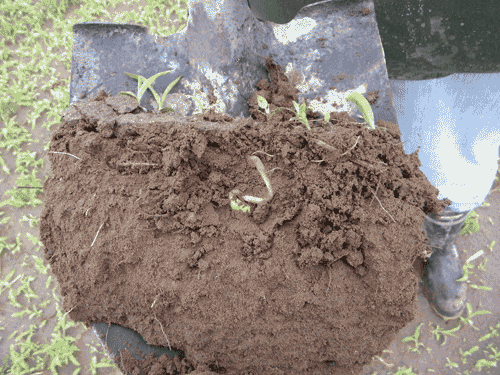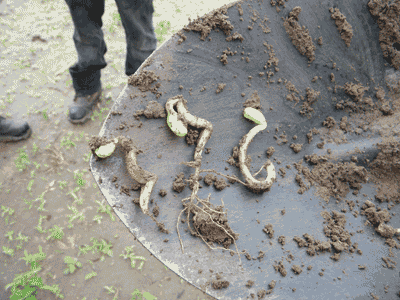Get ready, spring is here!
OMAFRA’S SPECIALISTS SHARE THEIR TOP TIPS TO PREPARE FOR THE 2011 SEASON
as the days get longer and the temperatures get warmer, the Ontario Grain Farmer asked the specialists from the Ontario Ministry of Agriculture, Food and Rural Affairs what they think should be top of mind as farmers head into the 2011 cropping season.
Optimal planting depth
Horst Bohner, Soybean Specialist
Achieving the right seeding depth can be difficult. A number of factors that will vary from one year to another, and often from field to field, need to be constantly monitored and adjusted. Early planted no-till fields are often planted too deep while later planted fields may not be planted deeply enough. The photos below show the results of planting too deep. These beans never emerged.


Consider the following when attempting to seed soybeans at the optimal depth:
Moisture
• Soybeans need to reach 50 percent water saturation in order to germinate
• Soybeans should be planted at least 1 cm (approx. 0.5 inch) into moisture
• With typical spring conditions, this moisture depth will be between 2.5 to 5cm (1 to 2 inches)
• Seed should not be planted deeper than 6.4 cm (2.5 inches), seedlings may
not emerge
• Soil moisture conditions change throughout the planting season, check the depth of moisture in the field being planted, adjust accordingly
• When seeding early, a 1 inch depth is usually adequate since the biggest problem with early seeding is
achieving emergence
Soil contact
• Seed must be planted deep enough to have adequate seed-to-soil contact with a closed seed slot, typically a minimum 2.5 cm (1 inch)
• Seed being dropped on the soil surface or in an unclosed seed slot has little chance of producing a plant
Soil type
• Different soil types need different planting depths
• Sandy soils require deeper planting to reach moisture, but seed has an easier time emerging
• Clay soils call for shallower planting to reach moisture, which also helps seed emerge if soil crusts
Equipment
• Planters have better seed placement and depth control than drills
• If possible, use coulters in no-till situations for both planters and drills to allow disk-openers to reach the proper depths and reduce hair pinning in seed slot
• Rolling fields after planting can help preserve soil moisture and close seed slots
Seed size
• Larger seeds have more potential energy to emerge from the soil
• Soybean varieties typically have an emergence rating or hypocotyl length rating as an indication of the seeds ability to emerge from the soil
• Check with your seed supplier for more details if this is a concern
Plant early and prep your equipment
Greg Stewart, Corn Specialist
Inflation information
Know your axle load, know your tires and run the correct inflation pressure! Two tractors with identical weight, tire type and size can have significantly different effects on soil compaction based completely on the inflation pressure at which the tires are operating.
The early bird gets the worm
If opportunities come along in 2011 to plant early, say April 22 and, be sure to take advantage of the greater yield potential of full season hybrids. Be prepared with seed and planters as soon as possible.
Plant carefully
Check your double disc openers with the Business Card Test: put a business card between the double disc openers and turn them to their point of contact. They should grab the business card so you can’t pull it out. The blades should hold the business card for one to two inches of travel. If it holds the business card for three inches of travel, there is too much tension.
On a single disc opener, check the size of the disc blades against a new one. If there is one inch of wear, you will need to adjust the level of the boot. Two inches of wear means replace. Be sure that the boots are being held tight against the disc blades, i.e.: that the little leaf springs haven’t disappeared and allowed the boots to flop around.
Prepping for success with spring and winter wheat
Peter Johnson, Cereal Specialist
Spring wheat
• Planting date is everything with spring wheat. Anything you can do to plant earlier will put more money in your pocket. Of all the spring cereals, spring wheat responds the most to an early planting date so it should be the first planted.
• Don’t ignore the potential benefits of a seed placed starter fertilizer. Whether it’s liquid or dry, starter fertilizers for spring wheat are important – especially if you are planting early.
• Plant carefully! Many spring cereal growers are primarily growing the crop for the straw and so they don’t pay close attention to planting. But, the return on yield will be bankable if you ensure your drill is well maintained. Be sure your drill is doing the best possible job of putting seed in the ground at a uniform depth. Use the Business Card Test outlined earlier.
Winter wheat
• Scout early in the spring for winter annual weeds like chickweed and shepherd’s purse and perennial weeds like dandelions so you can start planning an effective herbicide program.
• Take a walk through the field and look at the stand once the freeze-thaw cycle is complete. A good rule of thumb is to get out in the field once the maple syrup stops flowing. This signals the end of the freeze-thaw cycle and you can get a more accurate picture of what type of stand you’ll have. Don’t let green wheat fields fool you. Wheat plants that are damaged or dead from frost heave often green up anyway, before they run out of moisture and die. Scouting from the pickup truck can be very deceiving.
• For growers with late planted wheat, consider an early application of nitrogen. The field may need an extra boost to catch up with its early-planted neighbours. For those who planted early, an early N application is unnecessary.
Have a weed-free 2011
Mike Cowbrough, Weed Specialist
Resistant weed management
Populations of herbicide resistant weeds have been confirmed by the University of Guelph across Ontario. Visit us at ontariograinfarmer.ca for complete maps. This resistance has the greatest impact for weed management in non-GMO soybeans and will mean that:
Group 2 resistant:
• Ragweed will not be controlled by: Broadstrike RC, FirstRate, Pursuit and Classic
• Pigweed will not be controlled by: Broadstrike RC, Classic, FirstRate, Pinnacle and Pursuit
• Nightshade will not be controlled by: Broadstrike RC, Pursuit
• Lambsquarters’ will not be controlled by: Broadstrike RC, Pinnacle and Pursuit
• Fotxails will not be controlled by: Pursuit
When growing Roundup Ready crops
If you are a producer in southwest Ontario, populations of giant ragweed resistant to glyphosate exist. In corn you will have to tank-mix glyphosate with an effective residual herbicide (e.g. Marksman) to manage such resistant populations. In soybeans, preliminary research by Dr. Sikkema has shown that Eragon can be an effective pre-plant option with FirstRate being the most effective at controlling giant ragweed post-emergence to the crop.
Go to either www.weedpro75.com to plan a management strategy to address these weeds or OMAFRA Publication 75, Guide to Weed Control.
Herbicide timing in winter wheat
If you plan to use herbicides to control weeds, spray early (tillering). As the wheat crop gets more advanced (from first node to flag leaf), any potential stress imposed by an herbicide application will have a tendency to reduce yield and minimize any benefit.
| Application Timing | Yield |
| Early (Tillering, e.g. Late April) | 83 bu/ac |
| Intermediate (First Node, e.g. Early May) | 81 bu/ac |
| Late (Early Flag Leaf, e.g. Mid/Late May) | 76 bu/ac |
| *source: Melody DeJong, University of Guelph | |
Critical weed-free period in corn
Yield loss is minimized when corn is kept weed-free from the three- to eight-leaf stage. In glyphosate tolerant corn there are a number of ways to accomplish this (see Table 2).
Discourage disease
Albert Tenuta, Disease Specialist
• Variety selection and crop rotation continues to be the best defense against plant diseases. Review the disease ratings of your 2011 variety selections and place in the appropriate fields based on disease risk potential and history. Remember best defense is a good offense!
• Fungicidal seed treatments are a must if you are planting early and into fields with high residue levels. Remember cool, wet conditions are ideal for pathogens and insects which also increases entry points for these fungi.
• Scout early for disease problems whether it is wheat or new planting. Assessing disease problems early can help manage them as well as plan your attack whether it is re-planting or fungicides.
• Test soybean fields for Soybean cyst nematode (SCN). If you haven’t taken a SCN test recently you still have time to determine SCN levels and select appropriate SCN varieties.
• Consider tillage, but don’t go straight to the plow. You can have the best of both worlds – good residue coverage while reducing residue borne diseases.
Insect management
Tracey Baute, Pest Specialist
• Control annual weeds early and try to leave at least three weeks between weed kill and planting of corn to avoid black cutworm issues.
• Plant your refuge. Resistance to Bt corn is a serious threat, especially for corn rootworm and the seed companies and CFIA want to see improvement in refuge compliance. Make sure to plant the appropriate size and location of non Bt refuge according to the Bt traits you have purchased.
• Plant early but in good growing conditions. In particular, to reduce risk of Western bean cutworm infestations, select corn hybrids that flower early (no later than mid July) to avoid peak moth flight.
• Use Cruiser treated seed in both early and late planted soybean fields. 2011 has the potential to be a good soybean aphid year. Seed treatments can help control initial early season infestations. Also plan to do some scouting by the end of June, early July to stay ahead of any aphid infestations. •

| Strategy | Pros | Cons | Yield (%) |
| Two Pass Glyphosate glyphosate applied at the 3-4 leaf stage of corn and again at the 7-8 leaf stage of corn |
• Typically provides the best weed control and corn yields. • Better perennial weed control. |
• More expensive. • Increases selection pressure of glyphosate and chance of selecting herbicide resistant weed populations. |
100 |
|
PRE/POST glyphosate applied at the 7-8 leaf stage of corn |
• Typically provides the best weed control and corn yields. • Multiple herbicide modes of action to manage resistant weed populations. • Better perennial weed control. |
• More expensive. | 99 |
|
“One Pass” tank-mix with residual herbicide glyphosate + residual herbicide applied at the 3-4 leaf stage of corn |
• Only one application. • Multiple herbicide modes of action to manage resistant weed populations. |
• Timing too early to control many perennial weeds. • Reduced weed control when tank-mix partner does not provide residual control of weed spectrum in the field. |
97 |
|
“One Pass” Glyphosate (Early) glyphosate applied at the 3-4 leaf stage of corn |
• Only one application. | • Season long weed control not always possible. • Weeds emerging after application can significantly reduce yield. |
96 |
|
“One Pass” Glyphosate (Late) glyphosate applied at the 7-8 leaf stage of corn |
• Not recommended | • Not recommended | 90 |
| Yield data collected from 11 replicated trials during the 2007 and 2008 growing seasons. Source: Dr. P.H. Sikkema (University of Guelph, Ridgetown) and Dr. R. Nurse (AAFC, Harrow) |
|||






















